Clinical Reasoning Cycle Analysis: Mr. Joni's Health Complications
VerifiedAdded on 2022/11/14
|12
|1254
|195
Presentation
AI Summary
This presentation explores the clinical reasoning cycle (CRC) in the context of Mr. Tomasi Joni's health complications, specifically focusing on his severe risk of congestive heart failure (CHF). The presentation begins with an introduction to the CRC and its application in prioritizing patient care, then delves into Mr. Joni's medical history, including uncontrolled obesity, history of AMI, increased hypertension, and smoking, to assess his risk factors. The presentation identifies CHF as the primary health issue and discusses its pathophysiology, including the effects of hypertension, obesity, and smoking. The presentation establishes SMART goals for Mr. Joni, such as weight reduction and lifestyle changes and proposes interventions like exercise and health education. The presentation concludes by emphasizing the effectiveness of the CRC in identifying critical aspects for patient care and highlights the importance of patient and family involvement in the health education strategies. References from relevant medical literature support all the claims and interventions.
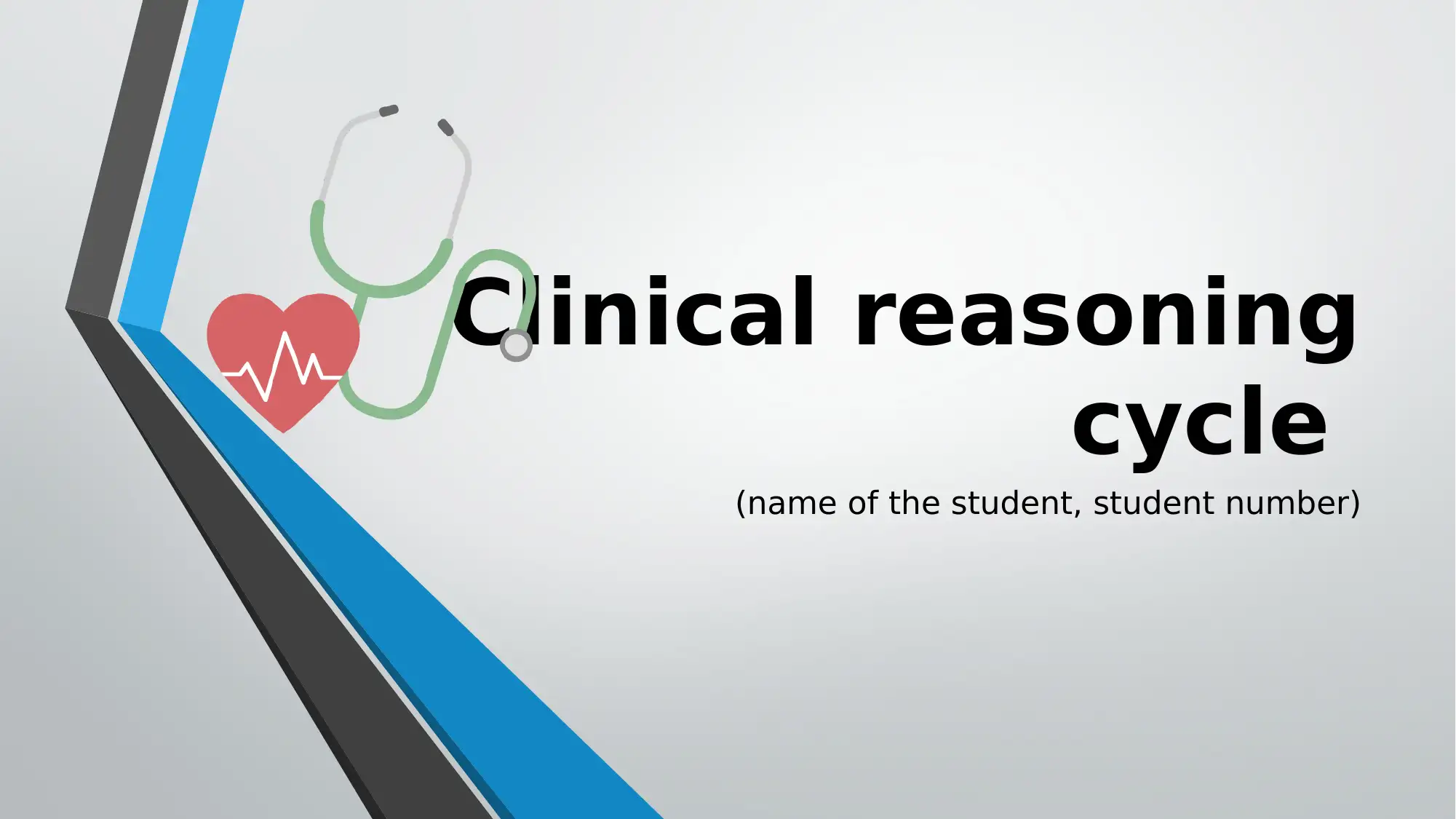
Clinical reasoning
cycle
(name of the student, student number)
cycle
(name of the student, student number)
Paraphrase This Document
Need a fresh take? Get an instant paraphrase of this document with our AI Paraphraser
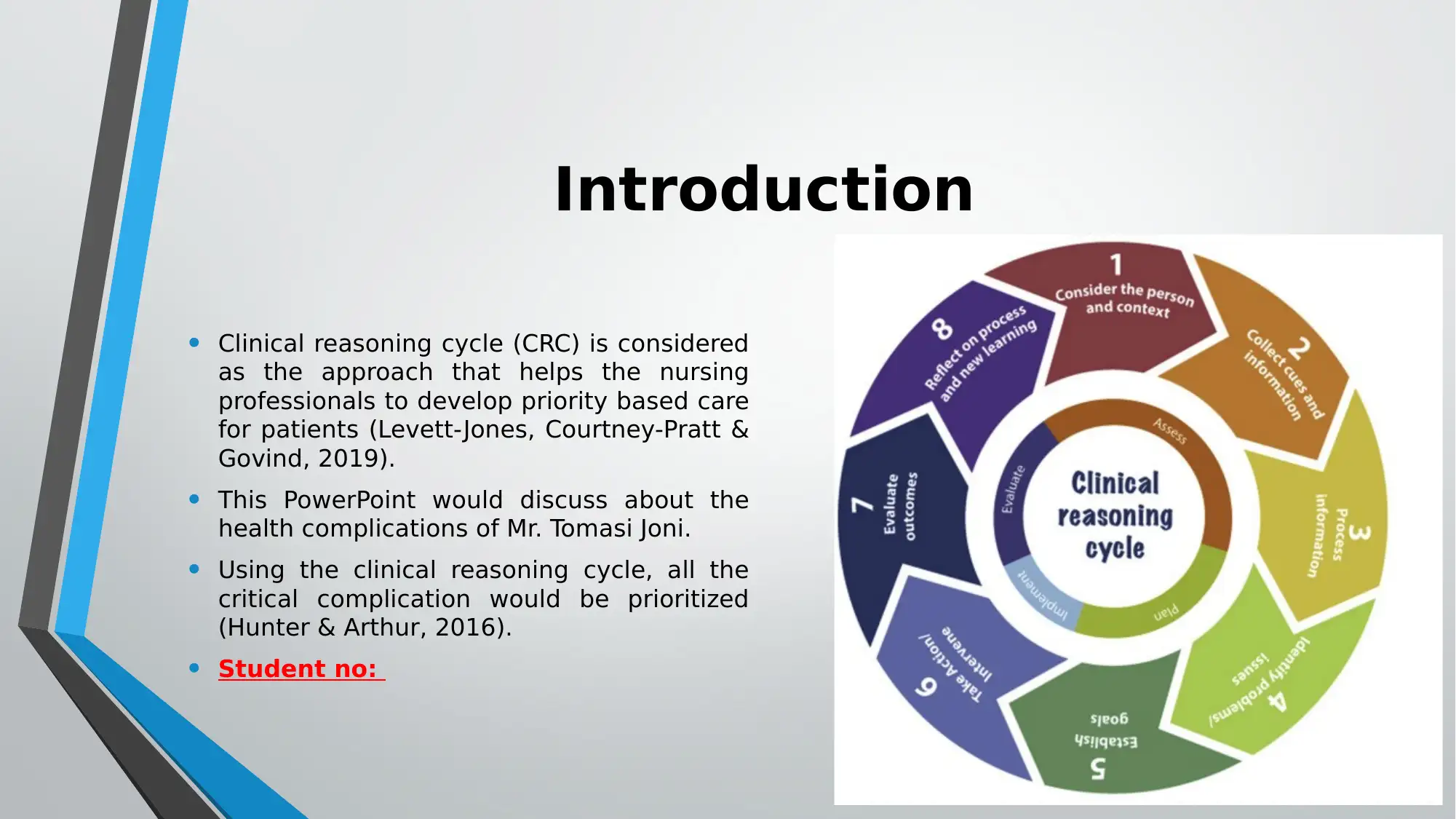
Introduction
• Clinical reasoning cycle (CRC) is considered
as the approach that helps the nursing
professionals to develop priority based care
for patients (Levett-Jones, Courtney-Pratt &
Govind, 2019).
• This PowerPoint would discuss about the
health complications of Mr. Tomasi Joni.
• Using the clinical reasoning cycle, all the
critical complication would be prioritized
(Hunter & Arthur, 2016).
• Student no:
• Clinical reasoning cycle (CRC) is considered
as the approach that helps the nursing
professionals to develop priority based care
for patients (Levett-Jones, Courtney-Pratt &
Govind, 2019).
• This PowerPoint would discuss about the
health complications of Mr. Tomasi Joni.
• Using the clinical reasoning cycle, all the
critical complication would be prioritized
(Hunter & Arthur, 2016).
• Student no:
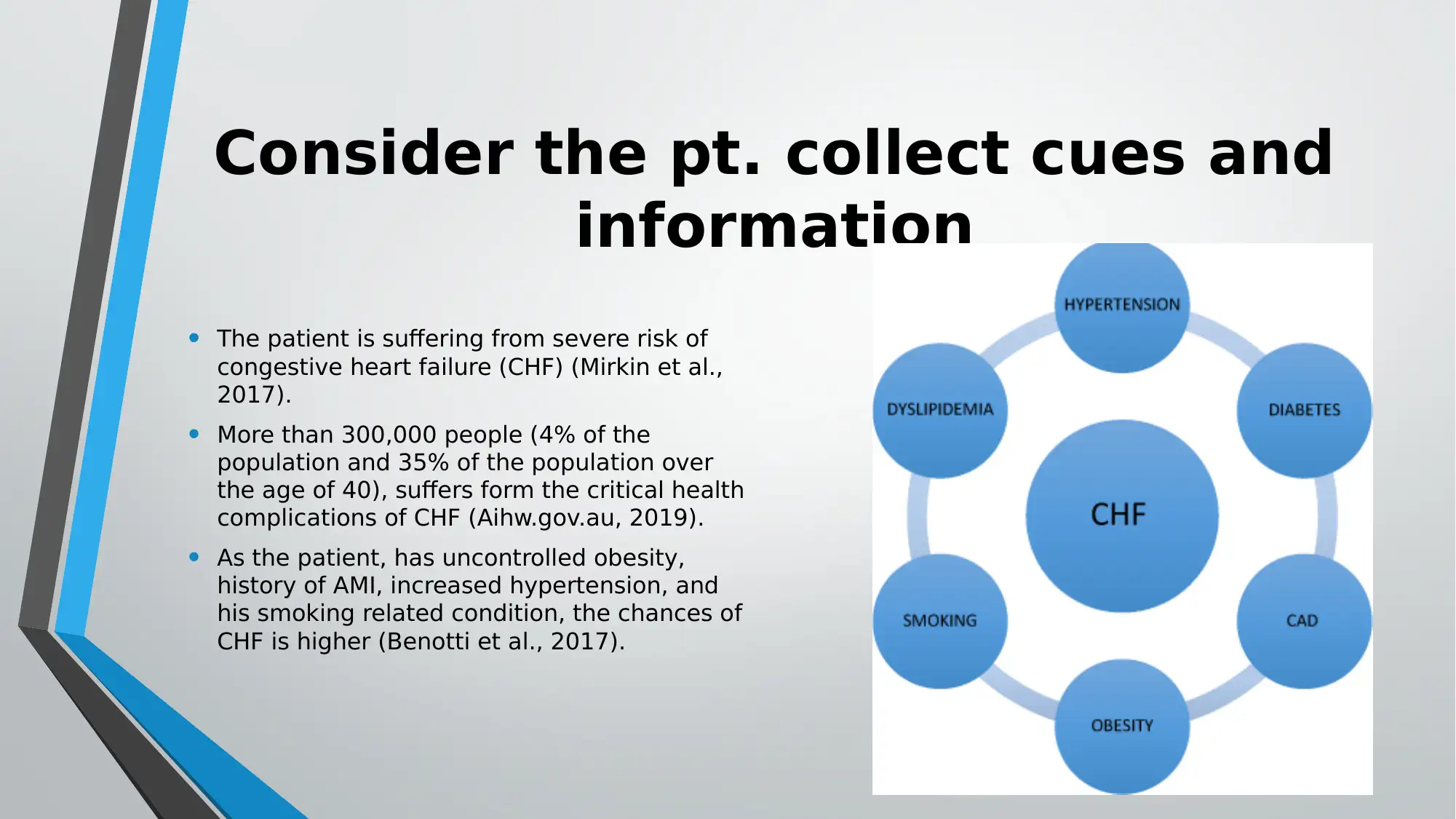
Consider the pt. collect cues and
information
• The patient is suffering from severe risk of
congestive heart failure (CHF) (Mirkin et al.,
2017).
• More than 300,000 people (4% of the
population and 35% of the population over
the age of 40), suffers form the critical health
complications of CHF (Aihw.gov.au, 2019).
• As the patient, has uncontrolled obesity,
history of AMI, increased hypertension, and
his smoking related condition, the chances of
CHF is higher (Benotti et al., 2017).
information
• The patient is suffering from severe risk of
congestive heart failure (CHF) (Mirkin et al.,
2017).
• More than 300,000 people (4% of the
population and 35% of the population over
the age of 40), suffers form the critical health
complications of CHF (Aihw.gov.au, 2019).
• As the patient, has uncontrolled obesity,
history of AMI, increased hypertension, and
his smoking related condition, the chances of
CHF is higher (Benotti et al., 2017).
⊘ This is a preview!⊘
Do you want full access?
Subscribe today to unlock all pages.

Trusted by 1+ million students worldwide
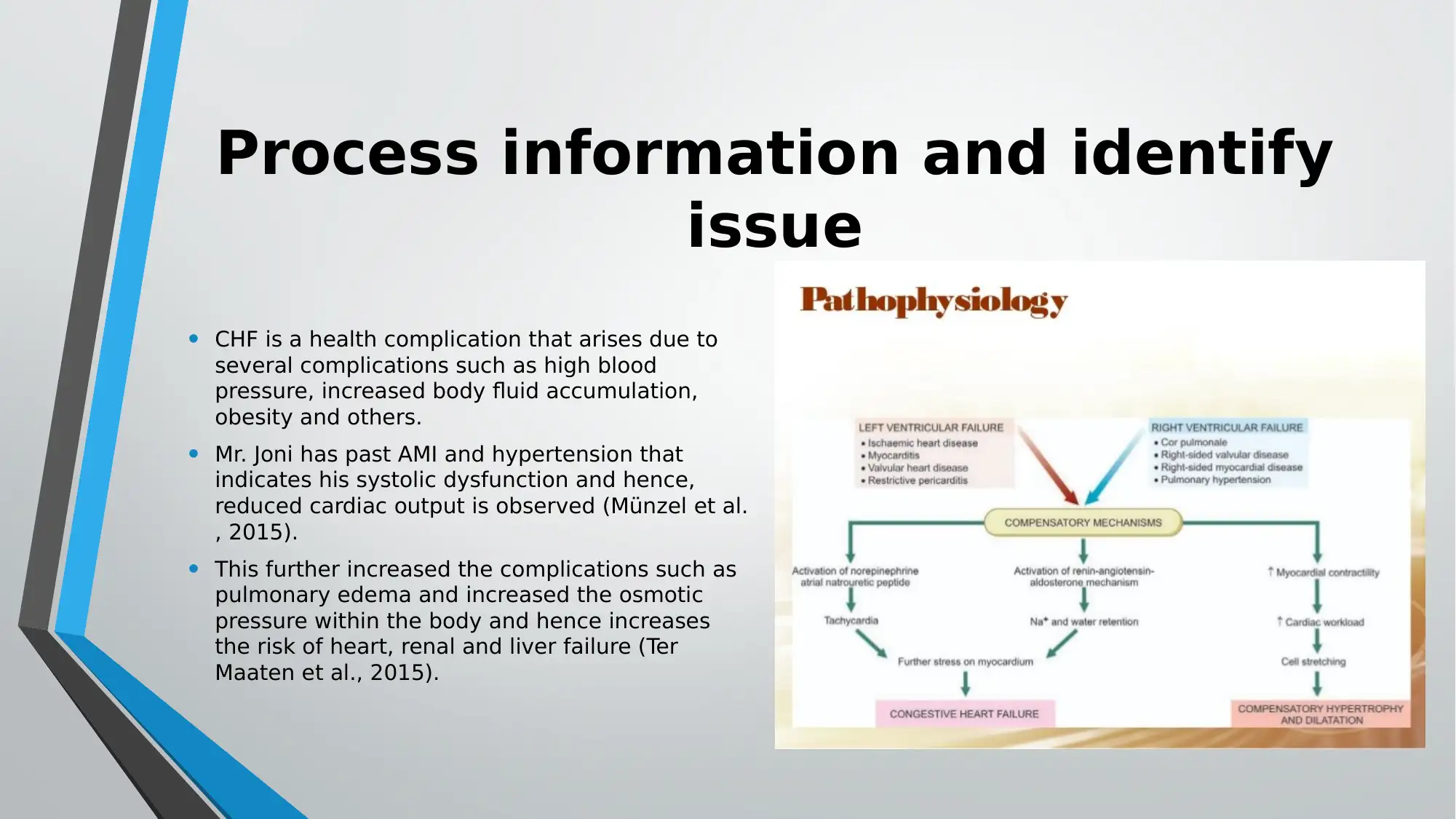
Process information and identify
issue
• CHF is a health complication that arises due to
several complications such as high blood
pressure, increased body fluid accumulation,
obesity and others.
• Mr. Joni has past AMI and hypertension that
indicates his systolic dysfunction and hence,
reduced cardiac output is observed (Münzel et al.
, 2015).
• This further increased the complications such as
pulmonary edema and increased the osmotic
pressure within the body and hence increases
the risk of heart, renal and liver failure (Ter
Maaten et al., 2015).
issue
• CHF is a health complication that arises due to
several complications such as high blood
pressure, increased body fluid accumulation,
obesity and others.
• Mr. Joni has past AMI and hypertension that
indicates his systolic dysfunction and hence,
reduced cardiac output is observed (Münzel et al.
, 2015).
• This further increased the complications such as
pulmonary edema and increased the osmotic
pressure within the body and hence increases
the risk of heart, renal and liver failure (Ter
Maaten et al., 2015).
Paraphrase This Document
Need a fresh take? Get an instant paraphrase of this document with our AI Paraphraser
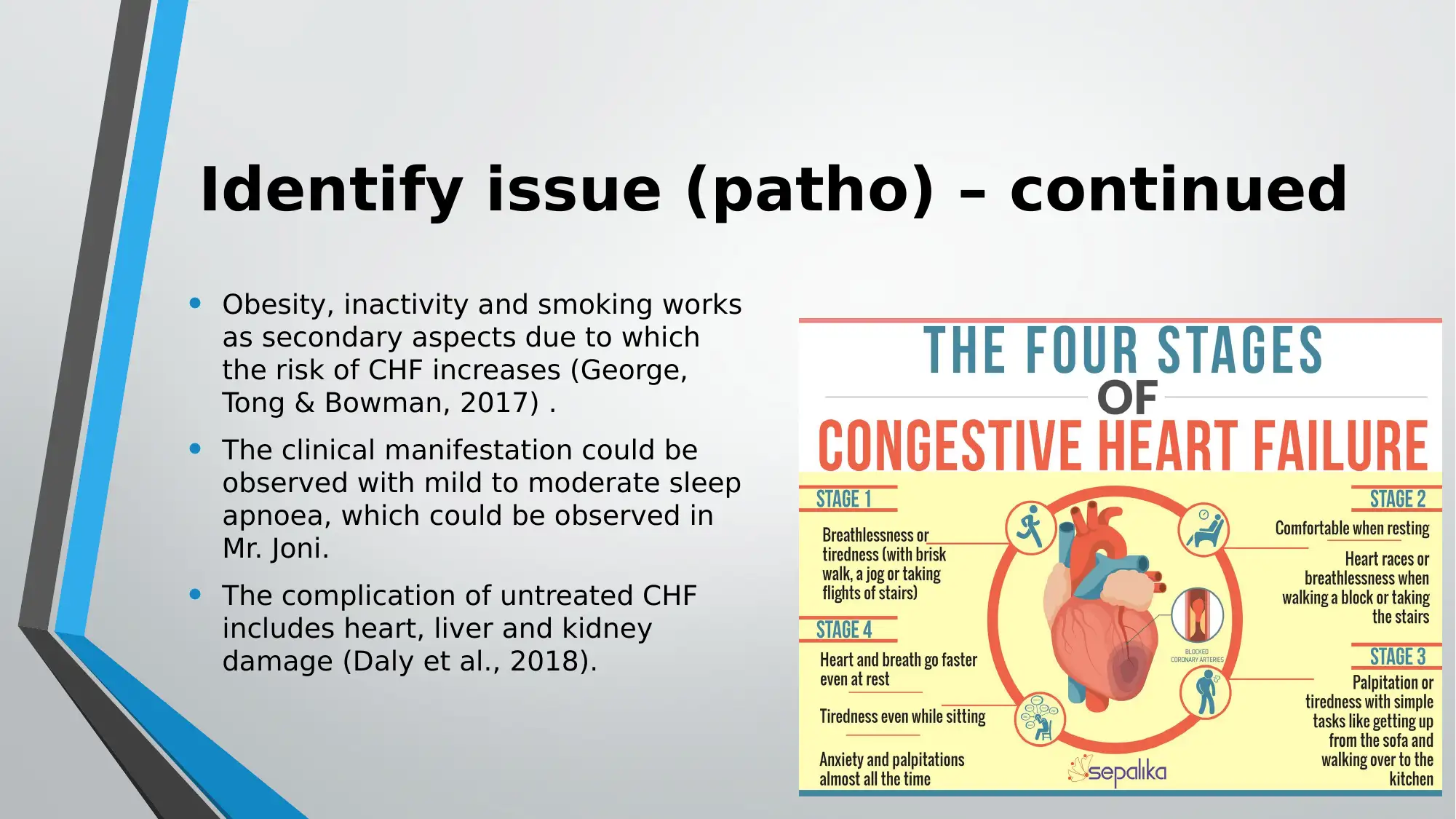
Identify issue (patho) – continued
• Obesity, inactivity and smoking works
as secondary aspects due to which
the risk of CHF increases (George,
Tong & Bowman, 2017) .
• The clinical manifestation could be
observed with mild to moderate sleep
apnoea, which could be observed in
Mr. Joni.
• The complication of untreated CHF
includes heart, liver and kidney
damage (Daly et al., 2018).
• Obesity, inactivity and smoking works
as secondary aspects due to which
the risk of CHF increases (George,
Tong & Bowman, 2017) .
• The clinical manifestation could be
observed with mild to moderate sleep
apnoea, which could be observed in
Mr. Joni.
• The complication of untreated CHF
includes heart, liver and kidney
damage (Daly et al., 2018).
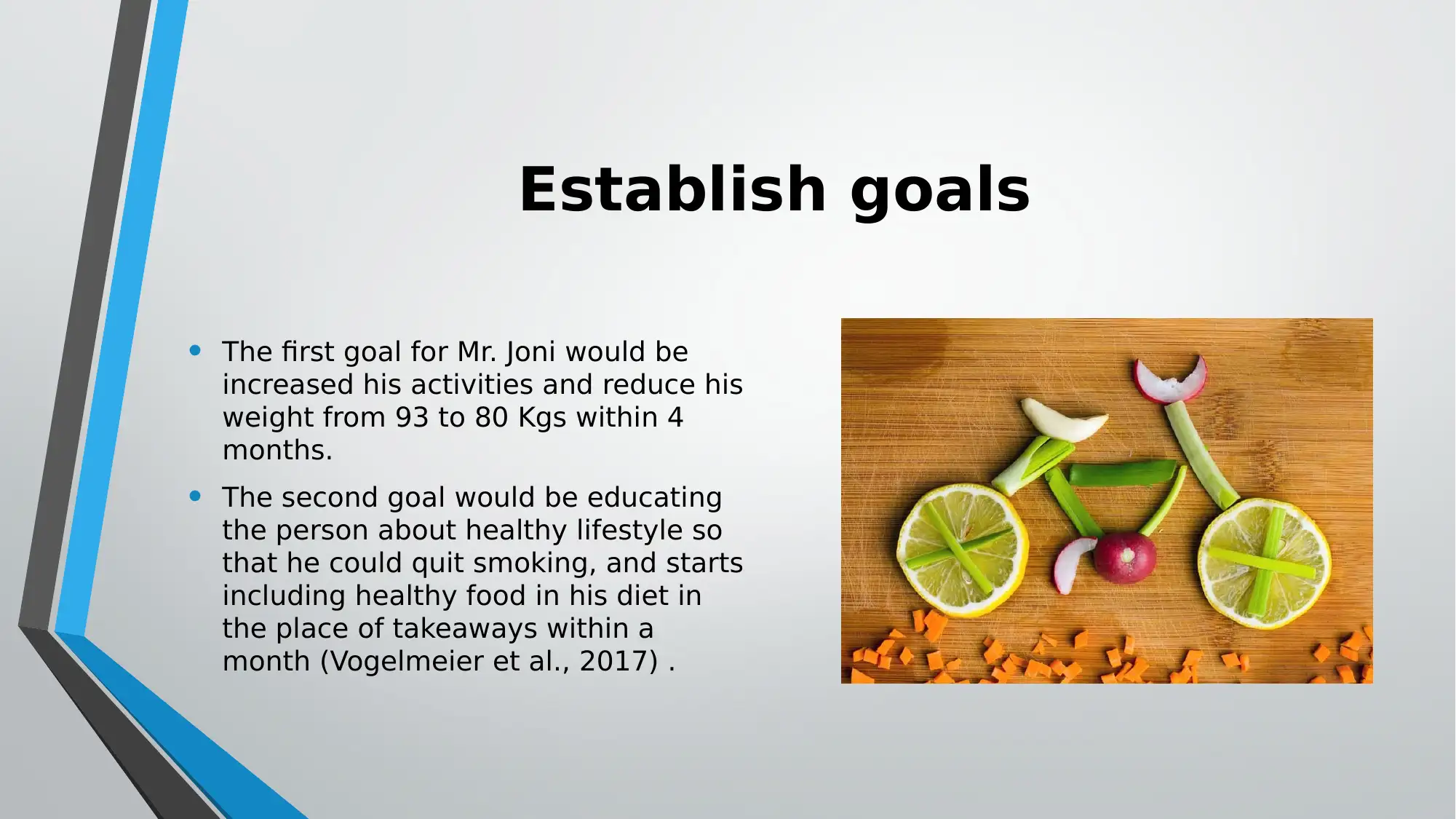
Establish goals
• The first goal for Mr. Joni would be
increased his activities and reduce his
weight from 93 to 80 Kgs within 4
months.
• The second goal would be educating
the person about healthy lifestyle so
that he could quit smoking, and starts
including healthy food in his diet in
the place of takeaways within a
month (Vogelmeier et al., 2017) .
• The first goal for Mr. Joni would be
increased his activities and reduce his
weight from 93 to 80 Kgs within 4
months.
• The second goal would be educating
the person about healthy lifestyle so
that he could quit smoking, and starts
including healthy food in his diet in
the place of takeaways within a
month (Vogelmeier et al., 2017) .
⊘ This is a preview!⊘
Do you want full access?
Subscribe today to unlock all pages.

Trusted by 1+ million students worldwide
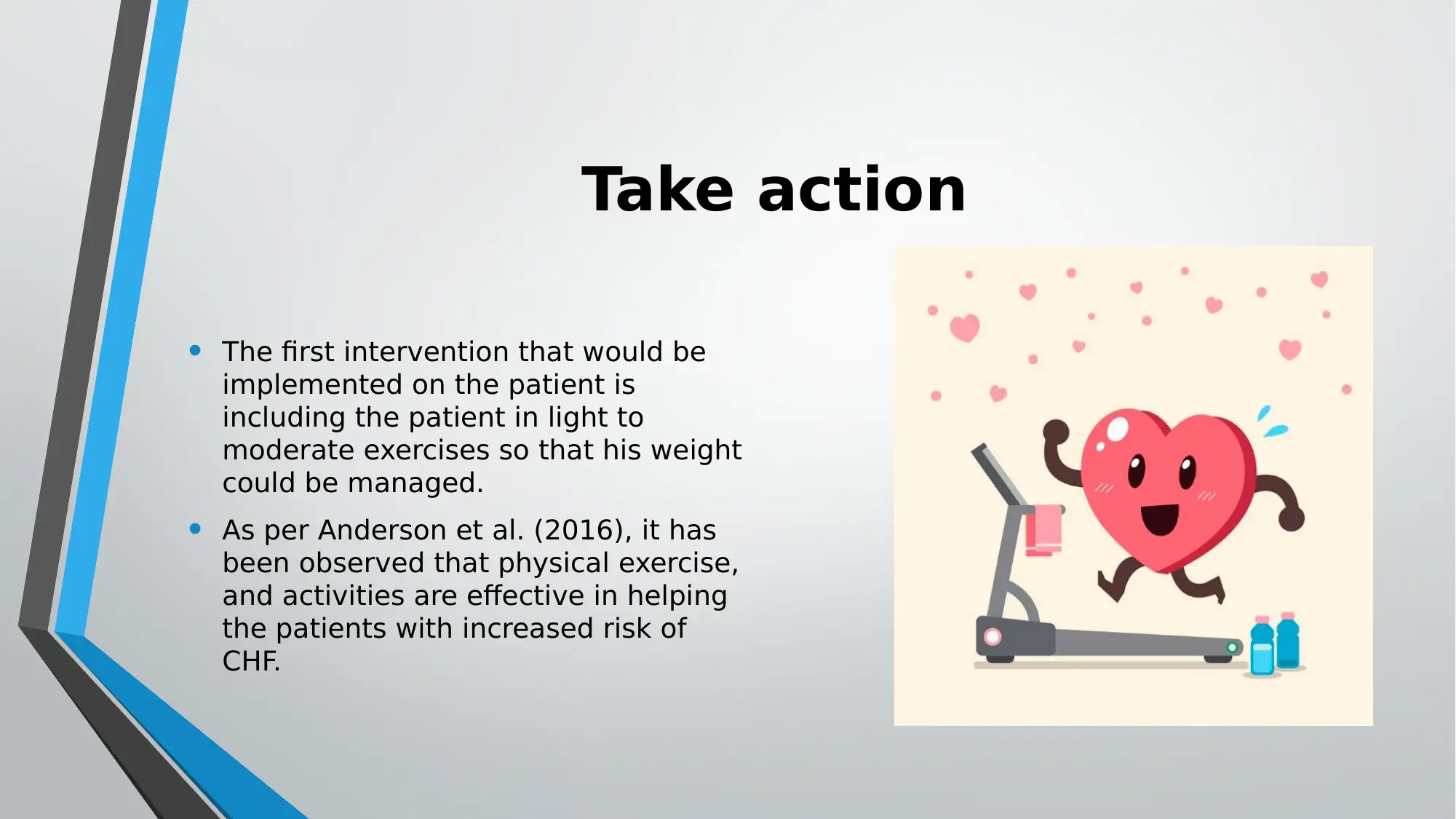
Take action
• The first intervention that would be
implemented on the patient is
including the patient in light to
moderate exercises so that his weight
could be managed.
• As per Anderson et al. (2016), it has
been observed that physical exercise,
and activities are effective in helping
the patients with increased risk of
CHF.
• The first intervention that would be
implemented on the patient is
including the patient in light to
moderate exercises so that his weight
could be managed.
• As per Anderson et al. (2016), it has
been observed that physical exercise,
and activities are effective in helping
the patients with increased risk of
CHF.
Paraphrase This Document
Need a fresh take? Get an instant paraphrase of this document with our AI Paraphraser
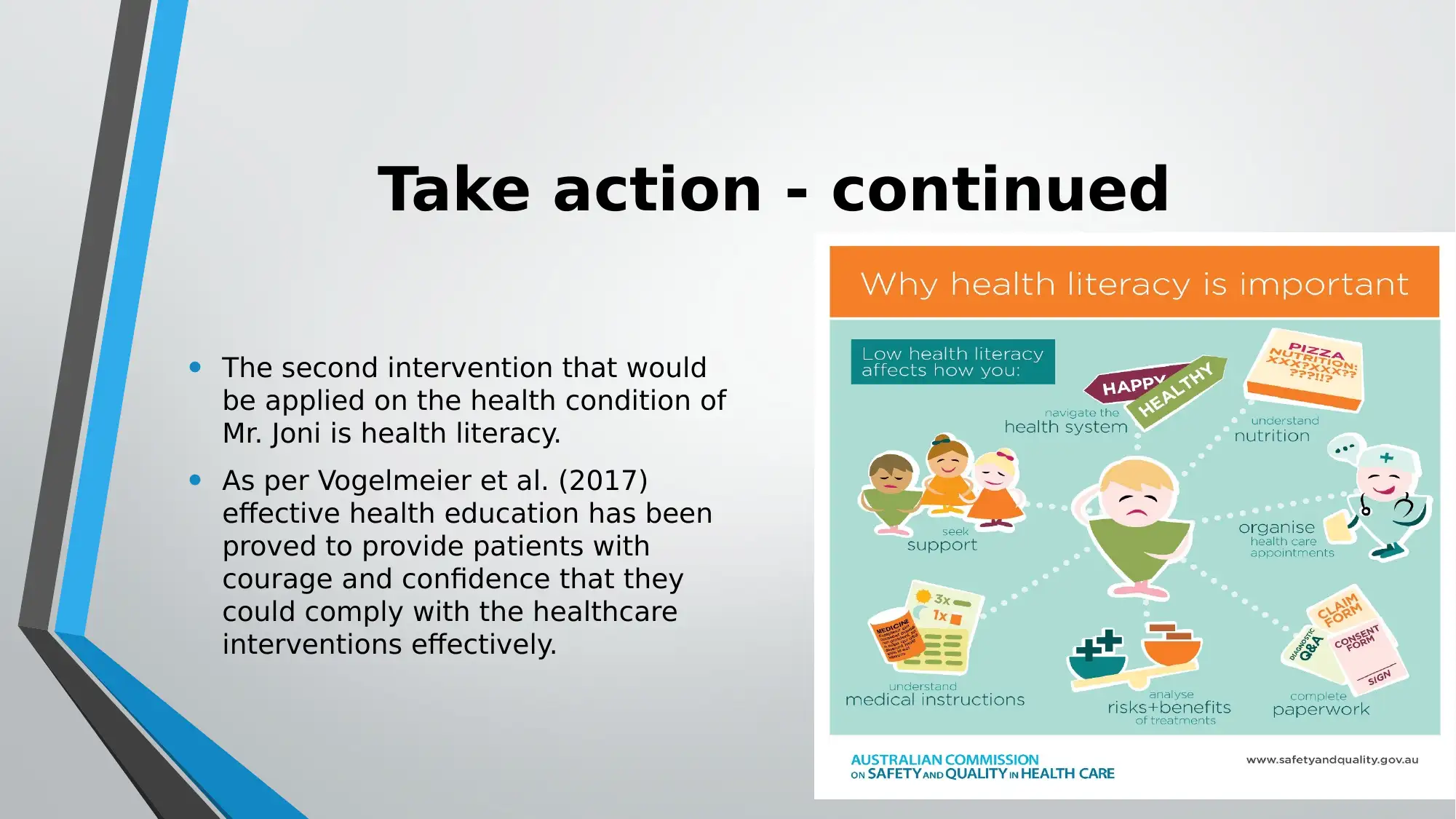
Take action - continued
• The second intervention that would
be applied on the health condition of
Mr. Joni is health literacy.
• As per Vogelmeier et al. (2017)
effective health education has been
proved to provide patients with
courage and confidence that they
could comply with the healthcare
interventions effectively.
• The second intervention that would
be applied on the health condition of
Mr. Joni is health literacy.
• As per Vogelmeier et al. (2017)
effective health education has been
proved to provide patients with
courage and confidence that they
could comply with the healthcare
interventions effectively.
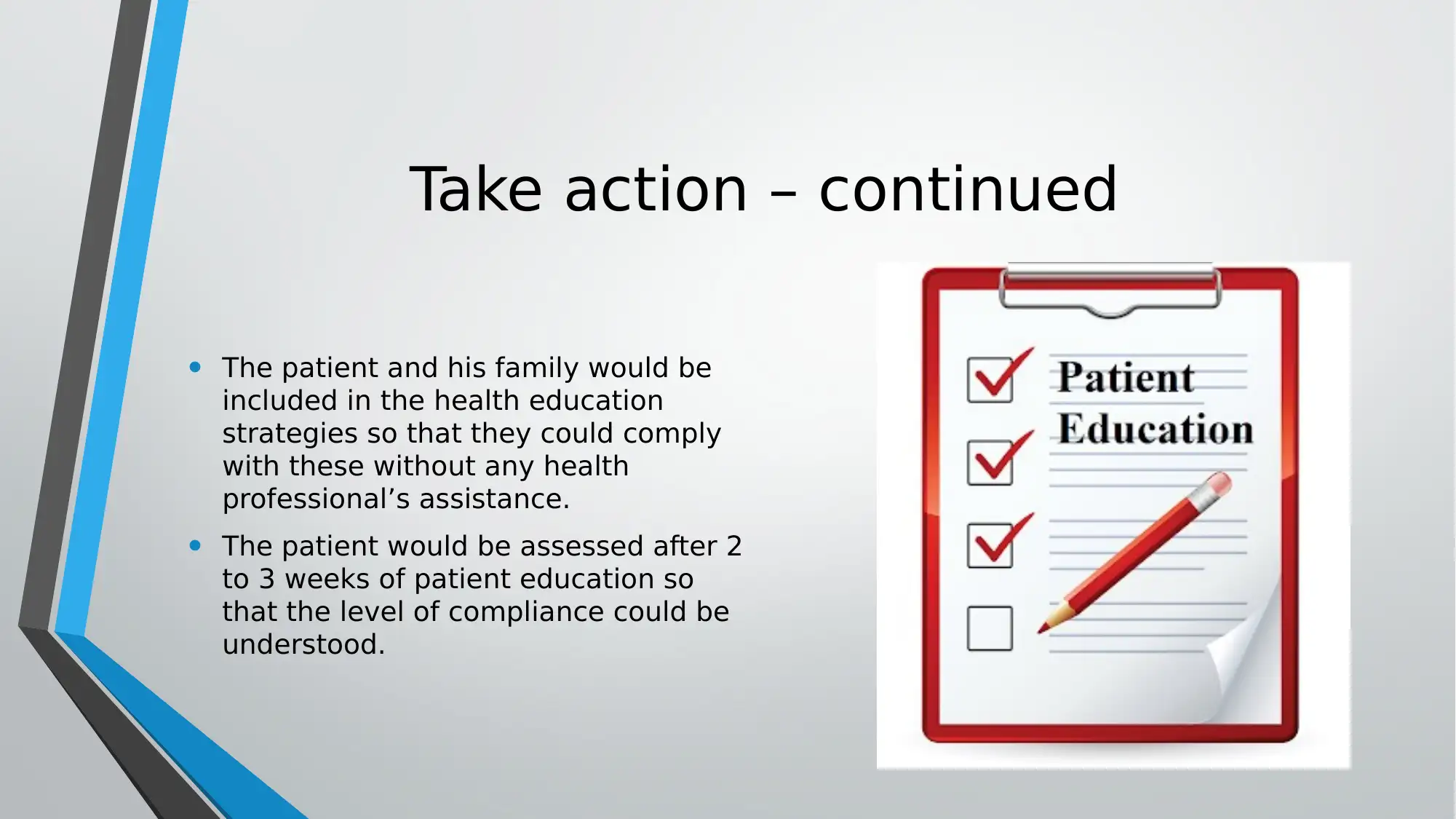
Take action – continued
• The patient and his family would be
included in the health education
strategies so that they could comply
with these without any health
professional’s assistance.
• The patient would be assessed after 2
to 3 weeks of patient education so
that the level of compliance could be
understood.
• The patient and his family would be
included in the health education
strategies so that they could comply
with these without any health
professional’s assistance.
• The patient would be assessed after 2
to 3 weeks of patient education so
that the level of compliance could be
understood.
⊘ This is a preview!⊘
Do you want full access?
Subscribe today to unlock all pages.

Trusted by 1+ million students worldwide
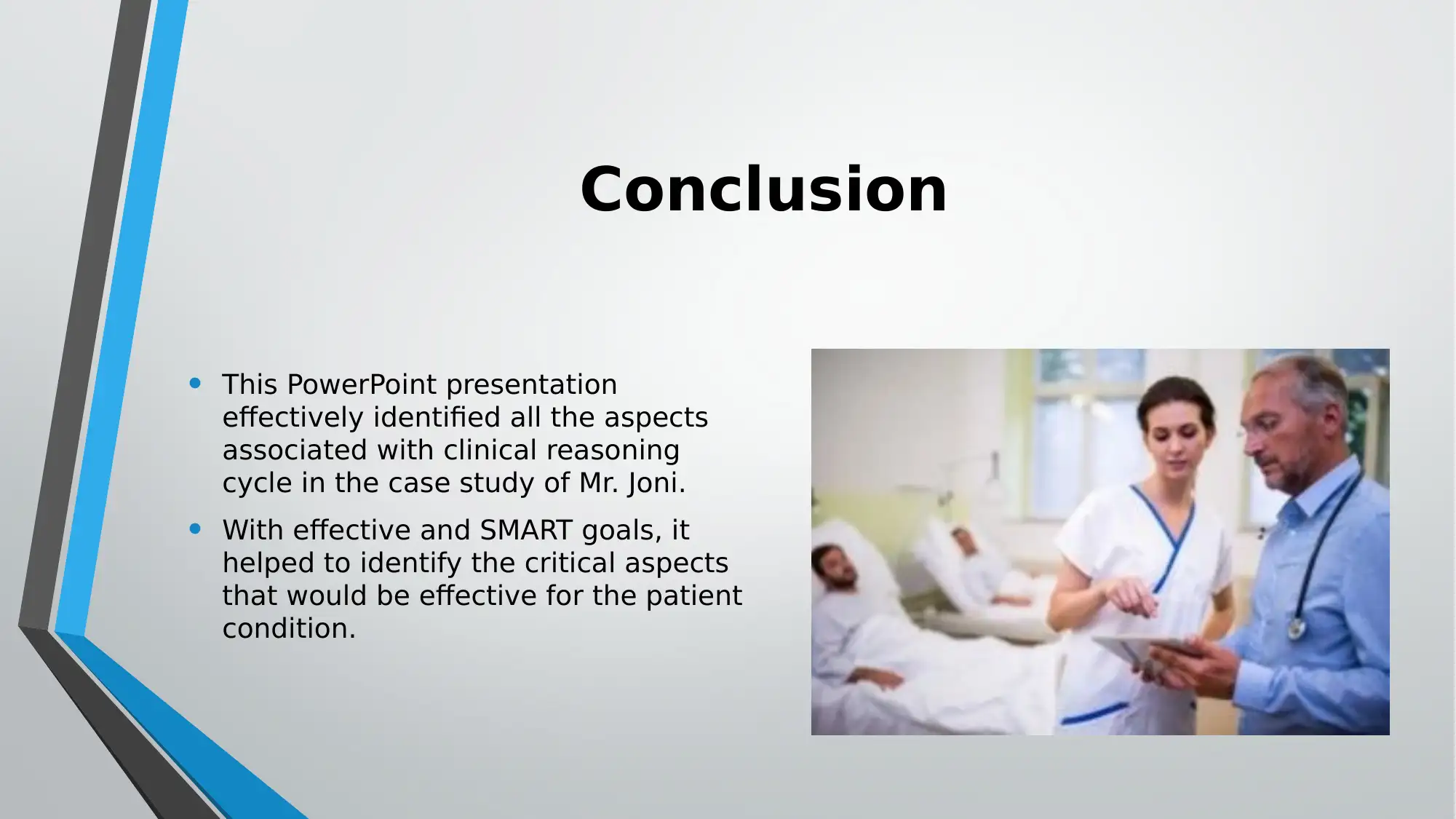
Conclusion
• This PowerPoint presentation
effectively identified all the aspects
associated with clinical reasoning
cycle in the case study of Mr. Joni.
• With effective and SMART goals, it
helped to identify the critical aspects
that would be effective for the patient
condition.
• This PowerPoint presentation
effectively identified all the aspects
associated with clinical reasoning
cycle in the case study of Mr. Joni.
• With effective and SMART goals, it
helped to identify the critical aspects
that would be effective for the patient
condition.
Paraphrase This Document
Need a fresh take? Get an instant paraphrase of this document with our AI Paraphraser
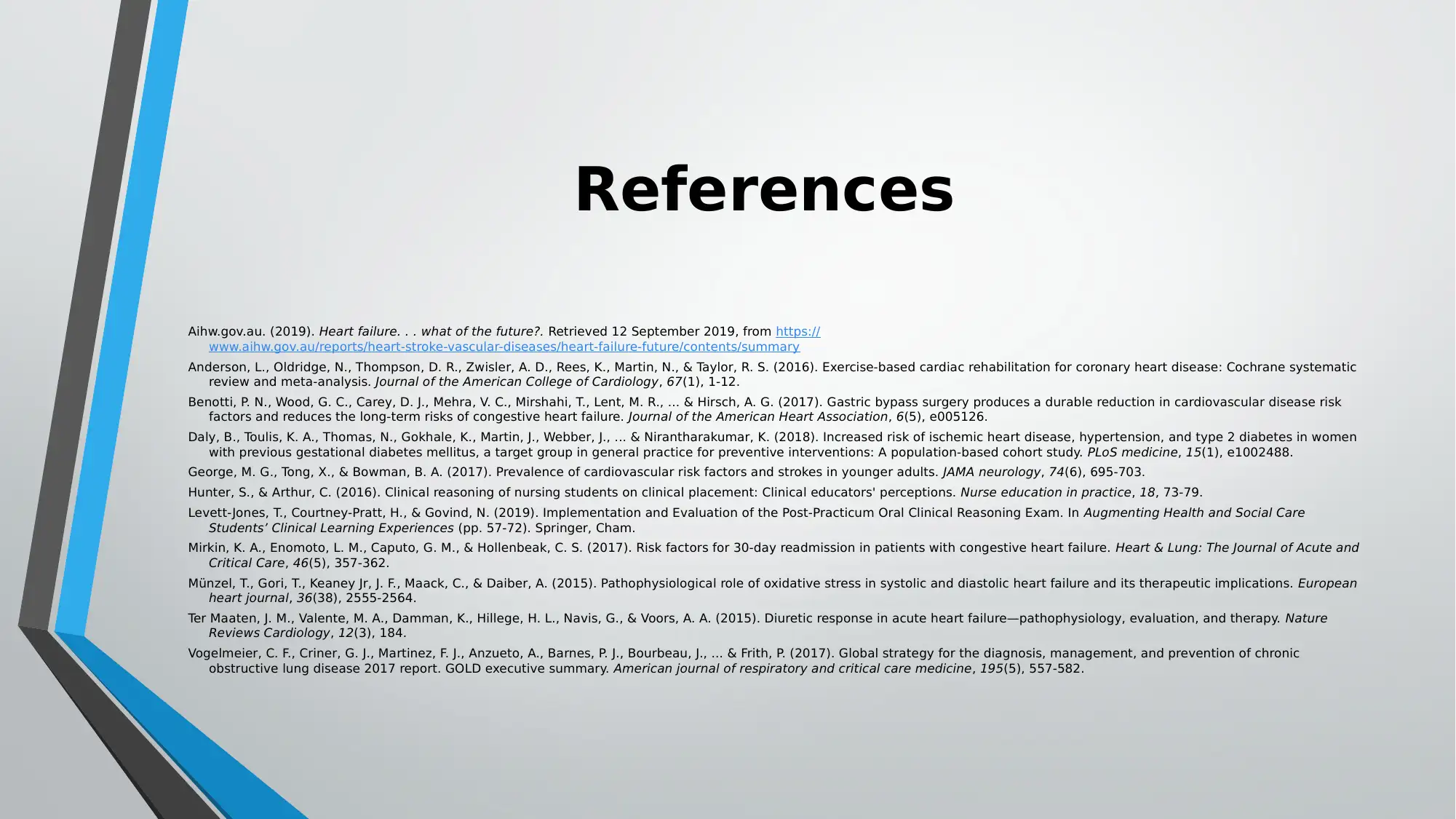
References
Aihw.gov.au. (2019). Heart failure. . . what of the future?. Retrieved 12 September 2019, from https://
www.aihw.gov.au/reports/heart-stroke-vascular-diseases/heart-failure-future/contents/summary
Anderson, L., Oldridge, N., Thompson, D. R., Zwisler, A. D., Rees, K., Martin, N., & Taylor, R. S. (2016). Exercise-based cardiac rehabilitation for coronary heart disease: Cochrane systematic
review and meta-analysis. Journal of the American College of Cardiology, 67(1), 1-12.
Benotti, P. N., Wood, G. C., Carey, D. J., Mehra, V. C., Mirshahi, T., Lent, M. R., ... & Hirsch, A. G. (2017). Gastric bypass surgery produces a durable reduction in cardiovascular disease risk
factors and reduces the long‐term risks of congestive heart failure. Journal of the American Heart Association, 6(5), e005126.
Daly, B., Toulis, K. A., Thomas, N., Gokhale, K., Martin, J., Webber, J., ... & Nirantharakumar, K. (2018). Increased risk of ischemic heart disease, hypertension, and type 2 diabetes in women
with previous gestational diabetes mellitus, a target group in general practice for preventive interventions: A population-based cohort study. PLoS medicine, 15(1), e1002488.
George, M. G., Tong, X., & Bowman, B. A. (2017). Prevalence of cardiovascular risk factors and strokes in younger adults. JAMA neurology, 74(6), 695-703.
Hunter, S., & Arthur, C. (2016). Clinical reasoning of nursing students on clinical placement: Clinical educators' perceptions. Nurse education in practice, 18, 73-79.
Levett-Jones, T., Courtney-Pratt, H., & Govind, N. (2019). Implementation and Evaluation of the Post-Practicum Oral Clinical Reasoning Exam. In Augmenting Health and Social Care
Students’ Clinical Learning Experiences (pp. 57-72). Springer, Cham.
Mirkin, K. A., Enomoto, L. M., Caputo, G. M., & Hollenbeak, C. S. (2017). Risk factors for 30-day readmission in patients with congestive heart failure. Heart & Lung: The Journal of Acute and
Critical Care, 46(5), 357-362.
Münzel, T., Gori, T., Keaney Jr, J. F., Maack, C., & Daiber, A. (2015). Pathophysiological role of oxidative stress in systolic and diastolic heart failure and its therapeutic implications. European
heart journal, 36(38), 2555-2564.
Ter Maaten, J. M., Valente, M. A., Damman, K., Hillege, H. L., Navis, G., & Voors, A. A. (2015). Diuretic response in acute heart failure—pathophysiology, evaluation, and therapy. Nature
Reviews Cardiology, 12(3), 184.
Vogelmeier, C. F., Criner, G. J., Martinez, F. J., Anzueto, A., Barnes, P. J., Bourbeau, J., ... & Frith, P. (2017). Global strategy for the diagnosis, management, and prevention of chronic
obstructive lung disease 2017 report. GOLD executive summary. American journal of respiratory and critical care medicine, 195(5), 557-582.
Aihw.gov.au. (2019). Heart failure. . . what of the future?. Retrieved 12 September 2019, from https://
www.aihw.gov.au/reports/heart-stroke-vascular-diseases/heart-failure-future/contents/summary
Anderson, L., Oldridge, N., Thompson, D. R., Zwisler, A. D., Rees, K., Martin, N., & Taylor, R. S. (2016). Exercise-based cardiac rehabilitation for coronary heart disease: Cochrane systematic
review and meta-analysis. Journal of the American College of Cardiology, 67(1), 1-12.
Benotti, P. N., Wood, G. C., Carey, D. J., Mehra, V. C., Mirshahi, T., Lent, M. R., ... & Hirsch, A. G. (2017). Gastric bypass surgery produces a durable reduction in cardiovascular disease risk
factors and reduces the long‐term risks of congestive heart failure. Journal of the American Heart Association, 6(5), e005126.
Daly, B., Toulis, K. A., Thomas, N., Gokhale, K., Martin, J., Webber, J., ... & Nirantharakumar, K. (2018). Increased risk of ischemic heart disease, hypertension, and type 2 diabetes in women
with previous gestational diabetes mellitus, a target group in general practice for preventive interventions: A population-based cohort study. PLoS medicine, 15(1), e1002488.
George, M. G., Tong, X., & Bowman, B. A. (2017). Prevalence of cardiovascular risk factors and strokes in younger adults. JAMA neurology, 74(6), 695-703.
Hunter, S., & Arthur, C. (2016). Clinical reasoning of nursing students on clinical placement: Clinical educators' perceptions. Nurse education in practice, 18, 73-79.
Levett-Jones, T., Courtney-Pratt, H., & Govind, N. (2019). Implementation and Evaluation of the Post-Practicum Oral Clinical Reasoning Exam. In Augmenting Health and Social Care
Students’ Clinical Learning Experiences (pp. 57-72). Springer, Cham.
Mirkin, K. A., Enomoto, L. M., Caputo, G. M., & Hollenbeak, C. S. (2017). Risk factors for 30-day readmission in patients with congestive heart failure. Heart & Lung: The Journal of Acute and
Critical Care, 46(5), 357-362.
Münzel, T., Gori, T., Keaney Jr, J. F., Maack, C., & Daiber, A. (2015). Pathophysiological role of oxidative stress in systolic and diastolic heart failure and its therapeutic implications. European
heart journal, 36(38), 2555-2564.
Ter Maaten, J. M., Valente, M. A., Damman, K., Hillege, H. L., Navis, G., & Voors, A. A. (2015). Diuretic response in acute heart failure—pathophysiology, evaluation, and therapy. Nature
Reviews Cardiology, 12(3), 184.
Vogelmeier, C. F., Criner, G. J., Martinez, F. J., Anzueto, A., Barnes, P. J., Bourbeau, J., ... & Frith, P. (2017). Global strategy for the diagnosis, management, and prevention of chronic
obstructive lung disease 2017 report. GOLD executive summary. American journal of respiratory and critical care medicine, 195(5), 557-582.

⊘ This is a preview!⊘
Do you want full access?
Subscribe today to unlock all pages.

Trusted by 1+ million students worldwide
1 out of 12
Related Documents
Your All-in-One AI-Powered Toolkit for Academic Success.
+13062052269
info@desklib.com
Available 24*7 on WhatsApp / Email
![[object Object]](/_next/static/media/star-bottom.7253800d.svg)
Unlock your academic potential
Copyright © 2020–2025 A2Z Services. All Rights Reserved. Developed and managed by ZUCOL.





